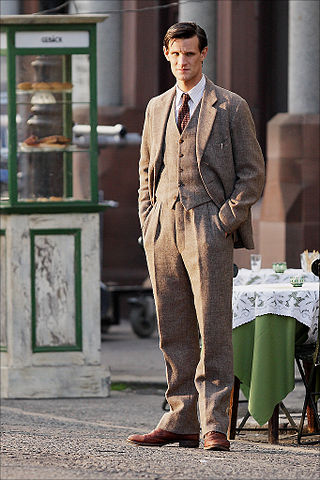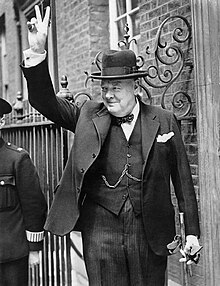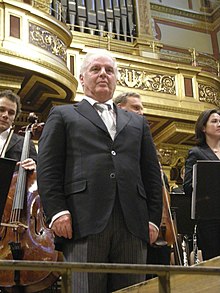
Black tie is a semi-formal Western dress code for evening events, originating in British and North American conventions for attire in the 19th century. In British English, the dress code is often referred to synecdochically by its principal element for men, the dinner suit or dinner jacket. In American English, the equivalent term tuxedo is common. The dinner suit is a black, midnight blue or white two- or three-piece suit, distinguished by satin or grosgrain jacket lapels and similar stripes along the outseam of the trousers. It is worn with a white dress shirt with standing or turndown collar and link cuffs, a black bow tie, typically an evening waistcoat or a cummerbund, and black patent leather dress shoes or court pumps. Accessories may include a semi-formal homburg, bowler, or boater hat. For women, an evening gown or other fashionable evening attire may be worn.

A waistcoat, or vest, is a sleeveless upper-body garment. It is usually worn over a dress shirt and necktie and below a coat as a part of most men's formal wear. It is also sported as the third piece in the traditional three-piece male suit. Any given waistcoat can be simple or ornate, or for leisure or luxury. Historically, the waistcoat can be worn either in the place of, or underneath, a larger coat, dependent upon the weather, wearer, and setting.

White tie, also called full evening dress or a dress suit, is the most formal evening Western dress code. For men, it consists of a black tail coat worn over a white dress shirt with a starched or pique bib, white piqué waistcoat and the white bow tie worn around a standing wing collar. Mid or high-waisted black trousers with galon, a braid of trim consisting of two silk stripes to conceal the outer seams of the trousers, along with court shoes complete the outfit. Orders, decorations and medals may be worn. Acceptable accessories include a black top hat, white gloves, a white scarf, a pocket watch, a white pocket square, and a boutonnière. Women wear full-length ball or evening gowns with evening gloves and, optionally, tiaras, jewellery, and a small handbag.

Court dress comprises the style of clothes and other attire prescribed for members of courts of law. Depending on the country and jurisdiction's traditions, members of the court may wear formal robes, gowns, collars, or wigs. Within a certain country and court setting, there may be many times when the full formal dress is not used. Examples in the UK include many courts and tribunals including the Supreme Court of the United Kingdom, and sometimes trials involving children.

A suit, lounge suit, or business suit is a set of clothes comprising a suit jacket and trousers of identical textiles generally worn with a collared dress shirt, necktie, and dress shoes. A skirt suit is similar, but with a matching skirt instead of trousers. It is currently considered semi-formal wear or business wear in contemporary Western dress codes, however when the suit was originally developed it was considered an informal or more casual option compared to the prevailing clothing standards of aristocrats and businessmen. The lounge suit originated in 19th-century Britain as sportswear and British country clothing, which is why it was seen as more casual than citywear at that time, with the roots of the suit coming from early modern Western Europe formal court or military clothes. After replacing the black frock coat in the early 20th century as regular daywear, a sober one-coloured suit became known as a lounge suit.
A tailcoat is a knee-length coat characterised by a rear section of the skirt, with the front of the skirt cut away.

Formal wear or full dress is the Western dress code category applicable for the most formal occasions, such as weddings, christenings, confirmations, funerals, Easter and Christmas traditions, in addition to certain state dinners, audiences, balls, and horse racing events. Generally permitted other alternatives, though, are the most formal versions of ceremonial dresses, full dress uniforms, religious clothing, national costumes, and most rarely frock coats. In addition, formal wear is often instructed to be worn with official full size orders and medals.

Mess dress uniform is the most formal type of evening-wear uniform used by military personnel, police personnel, and other uniformed services members. It frequently consists of a mess jacket, trousers, white dress shirt and a black bow tie, along with orders and medals insignia. Design may depend on regiment or service branch, e.g. army, navy, air force, marines, etc. In modern Western dress codes, mess dress uniform is the supplementary alternative equivalent to the civilian black tie for evening wear. Mess dress uniforms are typically less formal than full dress uniform, but more formal than service dress uniform.

1860s fashion in European and European-influenced countries is characterized by extremely full-skirted women's fashions relying on crinolines and hoops and the emergence of "alternative fashions" under the influence of the Artistic Dress movement.

Fashion in the 1890s in European and European-influenced countries is characterized by long elegant lines, tall collars, and the rise of sportswear. It was an era of great dress reforms led by the invention of the drop-frame safety bicycle, which allowed women the opportunity to ride bicycles more comfortably, and therefore, created the need for appropriate clothing.

1870s fashion in European and European-influenced clothing is characterized by a gradual return to a narrow silhouette after the full-skirted fashions of the 1850s and 1860s.

A frock coat is a formal men's coat characterised by a knee-length skirt cut all around the base just above the knee, popular during the Victorian and Edwardian periods (1830s–1910s). It is a fitted, long-sleeved coat with a centre vent at the back and some features unusual in post-Victorian dress. These include the reverse collar and lapels, where the outer edge of the lapel is often cut from a separate piece of cloth from the main body and also a high degree of waist suppression around the waistcoat, where the coat's diameter round the waist is less than round the chest. This is achieved by a high horizontal waist seam with side bodies, which are extra panels of fabric above the waist used to pull in the naturally cylindrical drape. As was usual with all coats in the 19th century, shoulder padding was rare or minimal.

Morning dress, also known as formal day dress, is the formal Western dress code for day attire, consisting chiefly of, for men, a morning coat, waistcoat, and formal trousers, and an appropriate gown for women. Men may also wear a popular variant where all parts are the same colour and material, often grey and usually called "morning suit" or "morning grey" to distinguish it; considered properly appropriate only to festive functions such as summer weddings and horse races, which consequently makes it slightly less formal. The correct hat would be a formal top hat, or if on less spacious audience settings optionally a collapsible equivalent opera hat.
Semi-formal wear or half dress is a grouping of dress codes indicating the sort of clothes worn to events with a level of formality between informal wear and formal wear. In the modern era, the typical interpretation for men is black tie for evening wear and black lounge suit for day wear, corresponded by either a pant suit or an evening gown for women.

Fashion in the years 1750–1775 in European countries and the colonial Americas was characterised by greater abundance, elaboration and intricacy in clothing designs, loved by the Rococo artistic trends of the period. The French and English styles of fashion were very different from one another. French style was defined by elaborate court dress, colourful and rich in decoration, worn by such iconic fashion figures as Marie Antoinette.

1880s fashion in Western and Western-influenced countries is characterized by the return of the bustle. The long, lean line of the late 1870s was replaced by a full, curvy silhouette with gradually widening shoulders. Fashionable waists were low and tiny below a full, low bust supported by a corset. The Rational Dress Society was founded in 1881 in reaction to the extremes of fashionable corsetry.

Fashion in the period 1900–1909 in the Western world continued the severe, long and elegant lines of the late 1890s. Tall, stiff collars characterize the period, as do women's broad hats and full "Gibson Girl" hairstyles. A new, columnar silhouette introduced by the couturiers of Paris late in the decade signaled the approaching abandonment of the corset as an indispensable garment.

Fashion from 1910 to 1919 in the Western world was characterized by a rich and exotic opulence in the first half of the decade in contrast with the somber practicality of garments worn during the Great War. Men's trousers were worn cuffed to ankle-length and creased. Skirts rose from floor length to well above the ankle, women began to bob their hair, and the stage was set for the radical new fashions associated with the Jazz Age of the 1920s.
A man's suit of clothes, in the sense of a lounge or business or office suit, is a set of garments which are crafted from the same cloth. This article discusses the history of the lounge suit, often called a business suit when featuring dark colors and a conservative cut.

Formal trousers, also known as formal striped trousers or colloquially spongebag trousers, are grey striped or patterned formal trousers for day attire in traditional Western dress code, primarily associated with formal morning dress or secondly its semi-formal equivalent black lounge suit. Traditionally made from heavy wool ranging from worsted, melton to partial twill weave, the pattern is most often of a muted design in stripes of black, silver, white and charcoal grey in various combinations. In addition, formal trousers may also come in check patterns, such as houndstooth check, or plaids, although these variants are widely considered as not the most formal.



























